Turns out the more immigrants the U.S. gets, the lower the crime rate.

What else are anti-immigrant advocates fibbing about?
Tip of the old scrub brush to Tyler Fisher (@tylrfishr).
Turns out the more immigrants the U.S. gets, the lower the crime rate.

What else are anti-immigrant advocates fibbing about?
Tip of the old scrub brush to Tyler Fisher (@tylrfishr).
From India today, not news to anyone who follows the fight against malaria, and the fight to save a part of the planet to preserve human life.
DDT resistance prompted India to agree to stop production of DDT by 2020 — the last DDT factory remaining. India’s disease fighters tell of frustration trying to control malaria, because abuse of DDT has bred DDT resistant and immune mosquitoes. This is not news.
But India Today has a news hole to fill, and the continuing crises of vector-borne diseases force public health agencies to turn to “fourth generation” pesticides, as insects are now resistant to DDT and malathion.
The story out of New Delhi on March 13 almost adds some poetry to the issue. I repeat the story from India Today in full, partly because I love the lilt of Indian English, and because it tells the story of continuing attempts to get ahead of pesticide resistance in pests, attempts that just don’t seem to be doing the job.
Delhi’s civic agencies asked to use fourth generation pesticides to kill chemical-resistant insects
A small vehicle fogging streets of Delhi, India, with DDT, to fight mosquitoes. File photo from India Today, used to illustrate the story only.
Pesticides such as DDT and malathion, which were once super weapons in the fight against mosquitoes, now seem to have become harmless perfume-like sprays for the blood-sucking parasites.
Scientists at the National Vector Borne Disease Control Programme (NVBDCP), Delhi which is the central nodal agency for prevention of diseases like malaria, dengue, filariasis, kala-azar, Japanese encephalitis and chikungunya, etc, in India has now recommended municipalities in the Capital and other parts of the country to shift to the 4th generation of pesticides that is also the last in the row.
These constitute certain bio-larvicides and insect growth regulators that stop the synthesis of critical hormones in mosquito larvae to prevent them from becoming adult. Only after attaining maturity, do the female Anopheles and Aedes Aegypti mosquitoes suck blood to get protein nutrition to lay eggs.
Scientists explain that the first generation of pesticides was DDT, used since World War II on soldiers in 1940s up till now, as its a powerful poison against mosquitoes. Later, its environmental effects, specifically on birds like vultures, reduced its usage globally.
Then came malathion, which had to be applied in huge quantities, paving the way for 3rdgeneration pesticides like synthetic pyrethroids and temephos. But with reports of mosquitoes developing tolerance towards all of these gradually, scientists are now recommending mixed and increased usage of the fourth generation of pesticides that is also the last line of defence in this class.
Experiments are still going on with genetically modified mosquitoes and introducing batches of mosquitoes injected with wolbachia bacteria in the wild to produce sterile eggs. A senior scientist with the NVBDCP, Civil Lines, said, Just like humans develop resistance towards antibiotics, mosquitoes have also evolved over the past 20-30 years to grow natural defence against DDT, malathion, etc. We are still using these two in virgin areas like forests of northeast India, Odisha, etc. successfully. But we have begun getting reports that even temephos and synthetic pyrethroids have stopped receiving the desired results against mosquitoes.
A pesticide is said to be successful when it kills over 90 per cent of the targeted insect or pest population. Over 3,500 species of mosquitoes, which play host to a number of disease-causing vectors such as zika, yellow fever, west Nile virus, etc. are said to be the deadliest animal family in the world. They kill 700 million people annually world over.
In Delhi itself, at least 10 people died of dengue last year and 9,271 people were affected.The numbers of malaria and chikungunya cases recorded in 2017 stood at 1,142 and 940. In 2016, at least 21 dengue deaths were reported from various city hospitals. And this year, an early onset of the deadly trio dengue, malaria and chikungunya is expected with summer-like weather conditions already.
High temperature and presence of clear water in desert coolers, flower pots, coconut shells, etc, act as excellent breeding sites for the menacing insects.
We have asked municipalities to even use the fourth generation of pesticides pirimiphos-methyl and diflubenzuron in a mix with the previous generation pesticides to delay mosquitoes developing tolerance towards this in the future, the scientist explained. He said, over the years, the pesticides must be rotated in use so that their effectiveness on hardy mosquitoes does not go down.
Dr Himmat Singh, senior scientist at the National Institute of Malaria Research (NIMR), Dwarka, said, The benefit with these two latest pesticides is that they are only hormone-inhibitors, not poisons, and specific to mosquitoes. So they wouldnt have any effect on other insects, birds, mammals, fishes, etc. They are categorised as non-hazardous by WHO. However, their cost has been prohibitive so far, he said.
Delhi municipalities have begun their use after a meeting of scientists and bureaucrats of NVBDCP, NIMR, ministry of health and family welfare and the Central Insecticide Board (CIB) authorised their application in January, sources said.
Dr NR Das, head of the department of Public Health in east MCD said, We have already procured diflubenzuron on NVBDCP directions and been using it for one month satisfactorily. However, we will be able to ascertain its degree of effectiveness only after two to three months.
For at least a decade, India has been the world’s largest producer of DDT, and the largest user, spraying more DDT than the rest of the world together. China and North Korea were the only two other nations making DDT at the end of the 20th century, but both cut off production. Counter to popular conceptions, India has struggled to control malaria, often being the only nation in the world to account increases in the disease from year to year, since 2001. Malaria increased despite increasing DDT application.
To fight malaria effectively DDT spraying should be limited to Indoor Residual Spraying (IRS), which leaves a fine coat of DDT on the walls of sleeping rooms, where malaria-carrying mosquitoes bite humans, then pause on the walls to squeeze water out of the blood they’ve fed on, to reduce weight to fly. Broadscale spraying of DDT only speeds development of resistance in all mosquito species, and many other pests.
India is catching up with the rest of the world on DDT.
Tip of the old scrub brush to India Today’s Twitter feed.
Most people know Rachel Carson wrote books before Silent Spring. Many libraries have a copy of The Sea Around Us.
But until now it’s been difficult to impossible to get anything else Carson wrote, or said. This unavailability boosts hoaxsters who create false tales about Carson’s intentions and motivations.

Cover of Rachel Carson: Silent Spring & Other Writings on the Environment, from the Library of America series
Comes now the Library of America series with a well curated volume that collects Carson’s writings, especially the shorter and sometimes more polemic pieces.
Just in time for the annual trotting out of hoaxes around DDT and malaria, for World Malaria Day, April 25.
If I ruled the world and time, I’d go back 20 years and replace President Trump’s bedside books with this one.
And mind you, I’ve not read it yet.
Tip of the old scrub brush to Professor Joanne Freeman.
Below the fold: A description of the volume and its editor, Sandra Steingraber, from Library of America.
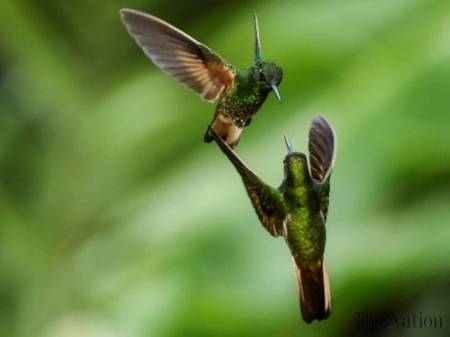
Two hummingbirds in Europe in 2017; will these birds go extinct, soon, due to agricultural use of potent pesticides that kill the insects birds need to live? AFP image via The Nation.
Bird populations appear to be collapsing across France, after insect populations crashed last year.
Neonicotinoid Pesticides generally get the blame.
France? You mean where “deja vu” is the native language?
It’s a serious problem.
Bird populations across the French countryside have fallen by a third over the last decade and a half, researchers have said.
Dozens of species have seen their numbers decline, in some cases by two-thirds, the scientists said in a pair of studies – one national in scope and the other covering a large agricultural region in central France.
“The situation is catastrophic,” said Benoit Fontaine, a conservation biologist at France’s National Museum of Natural History and co-author of one of the studies.
Some policy makers and scientists appear to have been caught off-guard by the dramatic decline in birds — but anyone watching to environmental news last year probably isn’t surprised. In 2017, scientists and farmers noted the crash of insect populations, the food of the birds. ‘Where have all the insects gone?’ asked a news story from Science Magazine.
Of the scant records that do exist, many come from amateur naturalists, whether butterfly collectors or bird watchers. Now, a new set of long-term data is coming to light, this time from a dedicated group of mostly amateur entomologists who have tracked insect abundance at more than 100 nature reserves in western Europe since the 1980s.
Over that time the group, the Krefeld Entomological Society, has seen the yearly insect catches fluctuate, as expected. But in 2013 they spotted something alarming. When they returned to one of their earliest trapping sites from 1989, the total mass of their catch had fallen by nearly 80%. Perhaps it was a particularly bad year, they thought, so they set up the traps again in 2014. The numbers were just as low. Through more direct comparisons, the group—which had preserved thousands of samples over 3 decades—found dramatic declines across more than a dozen other sites.
Insect declines were written about in Yale e360, and in news reports from Science. In 2017 scientists and others pondered causes for the decline, with research tending to point at new pesticides used in farming. Severity of the decline was alarming, but few sounded the alarms about birds last year.
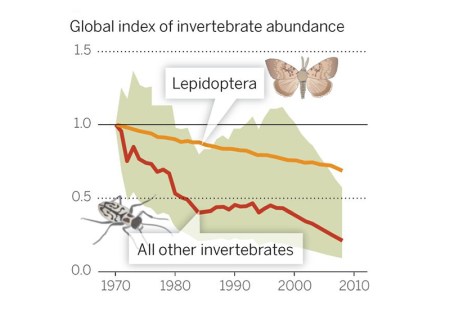
Chart showing the decline of insects worldwide, from Yale e360: “According to global monitoring data for 452 species, there has been a 45 percent decline in invertebrate populations over the past 40 years. DIRZO, SCIENCE (2014)”
These events are tragedies predicted by ecologists for years; it’s a replay of the “silent spring” Rachel Carson warned us of in her 1962 book — but the effects are much deeper, and moving much more quickly than almost anyone feared.
Can anyone devise a plan to stop the insect and bird decline, and get it up and operating in time to save Europe’s birds?
What if no one can?
More:
Tip of the old scrub brush to Guardian Environment.
Marjory Stoneman Douglas worked mostly outside of the spotlight, writing for Florida newspapers and magazines. Among other things, her collected works prompted Floridians to come to love the wild Everglades, and so to save this wonderful wilderness from drainage, and development.
In the past few decades someone named a high school after her, probably hoping to inspire a few women to greater achievement, and all students to good work.
You may know the rest of the story.
Recently someone made a banner of something Ms. Douglas said, and posted it on a fence near Marjory Stoneman Douglas High School in Parkland, Florida.
Ms. Douglas said:
Be a nuisance where it counts. Do your part to inform and stimulate the public to join your action. Be depressed, discouraged and disappointed at failure and the disheartening effects of ignorance, greed, corruption and bad politics — but never give up.
Words to live by, and help others to live.
Tip of the old scrub brush to @BrittanyWallman, “Senior reporter, South Florida Sun Sentinel, covering Fort Lauderdale and regional growth/development.”
Interesting Tweets from an organization in France, Les Amis de la Maison James Baldwin (The Friends of the House of James Baldwin), showing off his collection of records. They are recordings of music, on vinyl. Baldwin died in 1987, when it was still possible to avoid music on compact discs.
I love our old vinyl records. They have great works of art on the covers, often, and they have real notes in a readable font. We turned to CDs when some releases stopped coming on vinyl, after 1987.
Now it’s difficult to get CDs, and the tech magazines talk about the death of medium.
But in this short series of Tweets, more photos than words, Les Amis de la Maison James Baldwin take us back into his mind and art, and give us a glimpse of what could have been a wonderful time, sitting in his home in Paris, listening to great music on his record player — stereo I presume, though there is no information on what equipment he had.
He played some of it loud.
Good.

A photo of the vinyl record albums of James Baldwin, from the group that takes care of his home in Paris.
Diana Ross, Carmen McRae, Patti Labelle, more Carmen McRae, more Diana Ross, Donna Summer. Brenda Lee, Nina Simone and more Nina Simone. The Pointer Sisters. Deborah Brown Quartet (bet you don’t have that one in your collection). Aretha Franklin, “Here Comes the Sun” by Nina Simone, and more Aretha. One of the jazz albums produced by Creed Taylor (you have some of that, certainly). “From a Whisper to a Scream;” Allen Toussaint?
It’s a great collection in that first photo. We might expect polemics from Baldwin, but the polemic comes only from the entire field of artists and material. It’s the art he collected, and that carries a deeper, more powerful message than any one song or one artist.

Les Amis de Maison James Baldwin said, “Neighbors and friends recall music played at volume from the Baldwin villa.”
In the case of Aretha Franklin, “at volume” is a good thing, easily understandable. Heck, that’s true of every record in that collection.
Lou Rawls, Frank Sinatra, the Platters, Donny Hathaway, Roberta Flack and Donny Hathaway. Dinah Washington. Solid stuff.

Les Amis de Maison James Baldwin said: “James Baldwin occupied the villa on Chemin du Pilon from 1970 to 1987.”
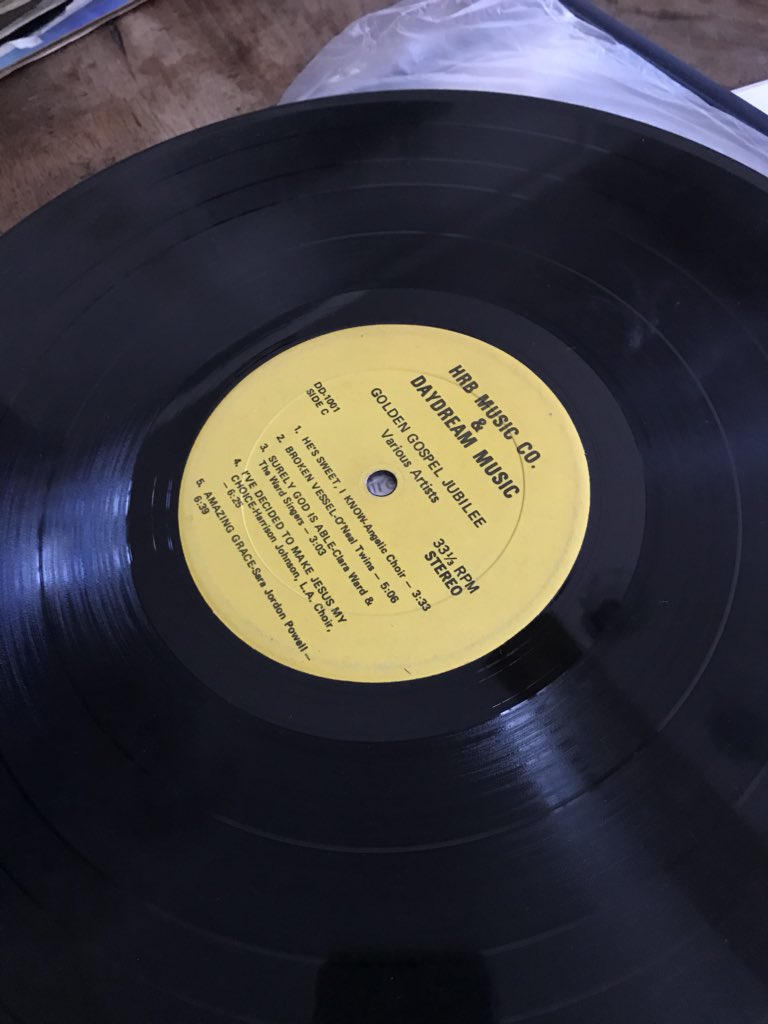
Les Amis de la Maison Baldwin captioned this photo: “He was reportedly entranced by gospel singer Sara Jordan Powell. He played her Amazing Grace again and again and again.”
Shirley Bassey, Bill Withers, Ray Charles, Otis Redding.
James Baldwin appears not to have had a very large collection of records in his home in France. But what he had, was great. A lot of artists are missing that we may wish Baldwin could have heard, and heard often in his own home. Perhaps he was just building up.
What a firm, great foundation.
More:
Cambodia’s last case of lymphatic filariasis showed up eight years ago.
WHO now declares Cambodia free of the mosquito-borne disease.
blogs.biomedcentral.com/on-health/2018/03/07/lymphatic-filariasis-has-been-eliminated-in-cambodia/

Cover of 1975 first album from Old and In the Way, a bluegrass band featuring Gerry Garcia, David Grisman, Vassar Clements and Peter Rowan, and John Kahn
Bluegrass Situation put together a play list of the key Jerry Garcia stuff all fans oughtta know — so it includes Grateful Dead and Old and In the Way.
You’ll probably have to sign in for Spotify (at Spotify.com), if you aren’t already registered — but if you’re a Garcia fan, it might be worth it.
If you’re not a Garcia and Dead fan, more is the pity.
It’s a good listen, any time.
Interesting news on the spread of culture, internationally.
www.economist.com/blogs/economist-explains/2018/03/economist-explains-7

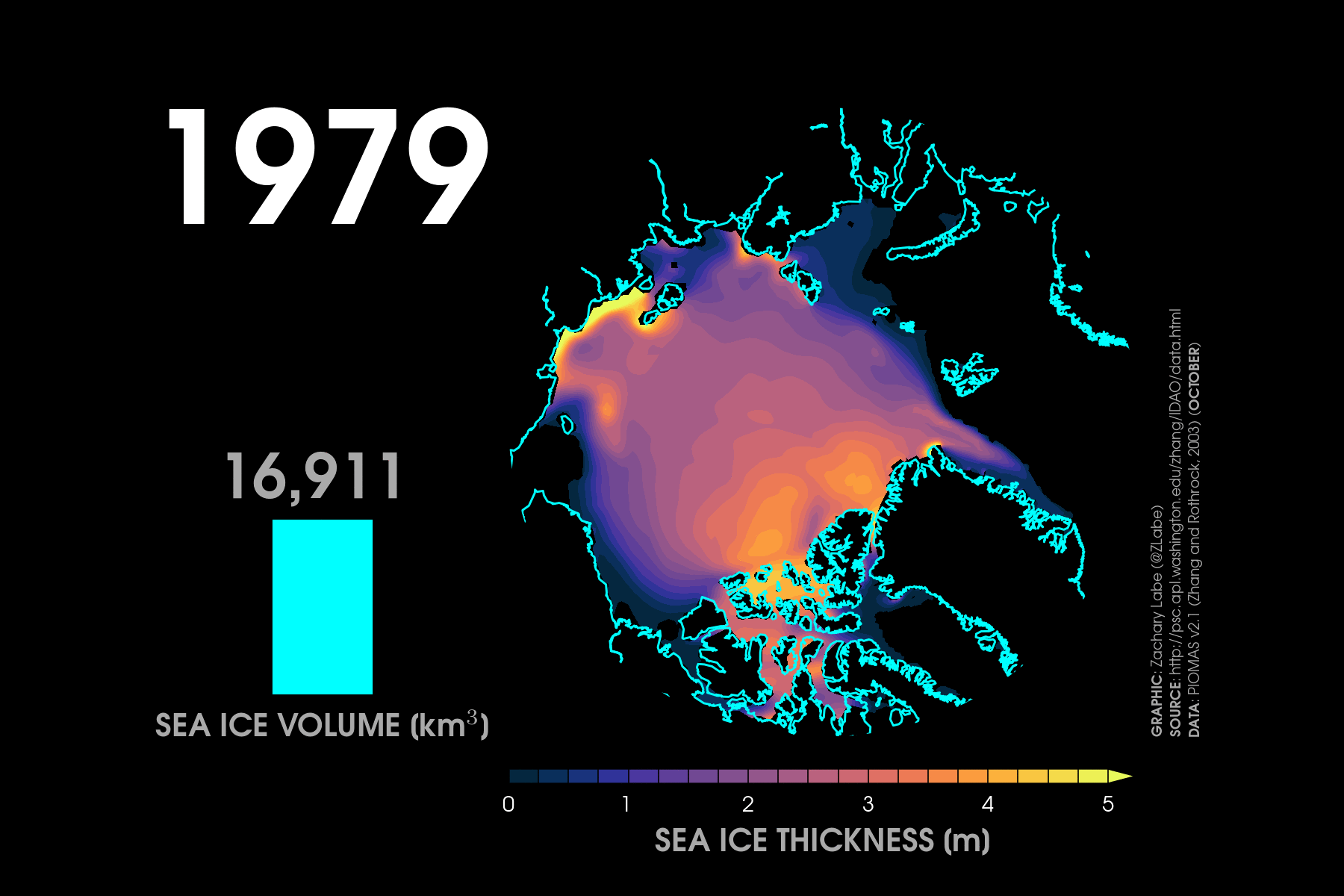
Zachary Labe’s animation showing decline of long-term ice in the Arctic. Long-term variability and loss of February #Arctic sea ice volume (left) and thickness (right) during the satellite era. Data from PIOMAS, graphic by Zachary Labe.
Polar bears need Goldilocks ice. There isn’t much.
Zachary Labe’s .gif shows the decline in ice thick enough from which polar bears can hunt, right up to 2018. Hunting areas for the bears decline, and bears will go hungry and cubs will die.
Polar bear researcher Andrew Derocher told us on Twitter what the graphic means:
Great graphic to refute deniers spouting that there’s more sea ice in the Arctic. For
#polarbears, it’s a Goldilocks scenario: sea ice can’t be too thick, too thin, too much, too little, it has to be just right. Of course, too thick isn’t an issue anymore.
Though the dangers to polar bears “isn’t an issue anymore” among scientists, it is also true that denialists, especially on blogs, Twitter and Facebook, drive opinion contrary to science and against the interest of the survival of polar bears. A paper by a group of scientists including members of the Polar Bear Specialist Group recently detailed that the internet legions of denial convince many people polar bears are not in trouble, making it difficult to work to save the animals.
Abstract
Increasing surface temperatures, Arctic sea-ice loss, and other evidence of anthropogenic global warming (AGW) are acknowledged by every major scientific organization in the world. However, there is a wide gap between this broad scientific consensus and public opinion. Internet blogs have strongly contributed to this consensus gap by fomenting misunderstandings of AGW causes and consequences. Polar bears (Ursus maritimus) have become a “poster species” for AGW, making them a target of those denying AGW evidence. Here, focusing on Arctic sea ice and polar bears, we show that blogs that deny or downplay AGW disregard the overwhelming scientific evidence of Arctic sea-ice loss and polar bear vulnerability. By denying the impacts of AGW on polar bears, bloggers aim to cast doubt on other established ecological consequences of AGW, aggravating the consensus gap. To counter misinformation and reduce this gap, scientists should directly engage the public in the media and blogosphere.
Reduced ice means smaller, less healthy cubs, hungrier less healthy mothers, hungrier, more-likely-to-eat-cubs males.
While denialists rage, the Earth still warms. Eppure, lei si scalda.
Tip of the old scrub brush to Andrew Derocher on Twitter.
Trump’ s middle America voters hurt still. Tax cuts make them hurt more, and. Trade war can’t help.
Trump has abandoned Americans.
Tip of the old scrub brush to Greg Sargent @ThePlumLineGS.
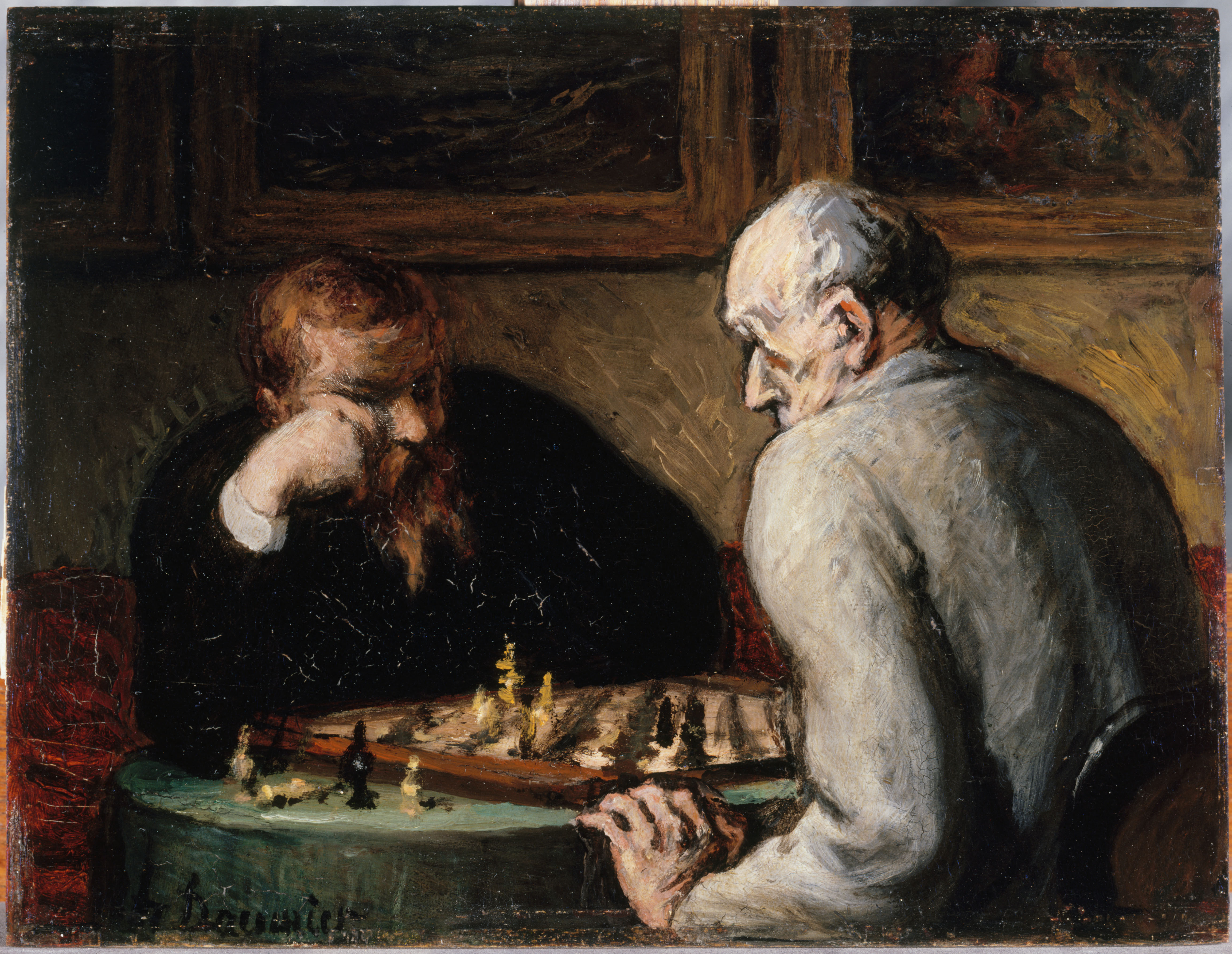
Honore Daumier (1808-1879), 1863 painting “The Chess Players” (“Les joueurs d’échecs”) Wikimedia image
You can find these two men playing chess in the Petit Palais, Paris.